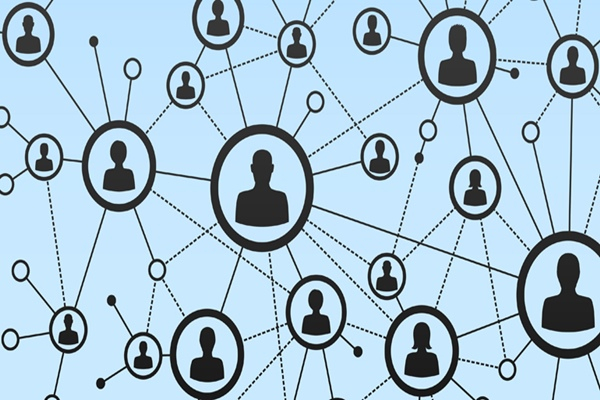The art of networking or building connects requires one to connect first, and then build the relationship into a long-term, mutually beneficial relationship. And the challenge for most of us, is not the build-up of the relationship later, it is the first CONNECT!
"Hi, I am Ajit Kamath, (in Hindi) log mujhe kehte hai Khaa... (pause) mat, lekin mera naam hai Ajit Kamath." [ "Hi, I am Ajit Kamath, people tell me DON'T EAT!, however my name is Ajit Kamath"].
For a bit-plump-on-the-sides me, this gives a smile on the face of the person I am meeting for the first time and then our conversation moves forward. I have been asked, why do I say this? And I answer "Why Not?" I have had students, managers and leaders remember me and the work I do by this humorous introductory line! And, if there is a high recall (meaning the next time I bump into the person, they can at least recall my name), then this is a million dollar intro for me. The art of networking or building connects requires one to connect first, and then build the relationship into a long-term, mutually beneficial relationship. And the challenge for most of us, is not the build-up of the relationship later, it is the first CONNECT! Networking is about networking purposefully with identified contacts. This is not about having extrovert behaviour and networking to every Tom, Dick and Harry you meet!
How does one become a polished networker?
Use the POWER Connect framework
POWER stands for:
P — PRAISE
O — OWN REMEMBRANCE
W — WANT HELP!
E — EXPERTISE LANDING / EXCHANGE CARDS
R — REMOVE SELF
This is like the gear that gets the car moving. Having an acute sense of observation is important-if done with authenticity and finesse, the conversation moves smoothly, else, be ready for jerks. Going up to a conference speaker and saying, "I liked your talk and especially when you said (verbatim few gems of the speakers wisdom) "………….". Other statements that work in meetings are, "Your Questions brought a lot of depth in the conversation and especially when you asked .......……." "I couldn't help notice you; you bring a distinct energy to this room" etc. If the above looks uncomfortable, then you need to do your homework. Go to social links and look at the connects profile. Pick perspectives on the person—work, school/college, recommendations, social connects etc., and use it. For e.g. "I looked at your LinkedIn profile and saw that you are a qualified Lawyer, I was wondering how come a lawyer is into learning and development..."
P — Praise / Appreciation
The first step is creating feel good in the connect.
What do bad first connect networkers do?
◆ Pushing Business cards
◆ Only objective is to get the others' business card
◆ Over-enthusiasm—showing off that you are best at everything!
◆ Submissive—making yourself too small in front of the connect
◆ You connect and then 'Stick Around' unnecessarily like a pest
◆ Too much of Extrovertedness—you do not stop talking!
◆ Lack of focussed conversation—while speaking to someone, your eyes are searching out for another people to connect
O — Own Remembrance
The second step is where the stickiness part comes in.
What's so unique about your name? What will stick? What will create high-recall? See that you stick in their minds- my advice is that it should be the name. However, if you are one of the plain Janes (do not curse your parents for this!) then go ahead and pick up something from your specialization to say, or maybe if you have received an award you can use this too—may sound a bit pompous though! And then, add in about two more sentences on what you do/are. Make it like an elevator pitch- a short powerful pitch that makes you stand high (and beware of overdoing it!). Some people use the extravagance of materialistic things to create stickiness-powerful attire, revealing dress, unique hairstyle, branded purse, branded pen, car, bike etc. iPhone and Mac have stopped creating that impression nowadays.
W — Want Help! (The Ask)
The third step—the principle of reciprocity—is all about give and take. Here, we set up the 'take' first.
Be ready with your "I need help/ support!" The help request should be a request for knowledge and/or expertise. It could be in the form of instant advice request or could be in the form of reaching out later (…and that is better for building the relationship). This works because with ask for help/support, especially related to knowledge, skills enhancement, mentorship, you put the other on a pedestal position (psychological power position)—the connect feels good about you, and therefore, remembers you! However, do not use this strategy/ tool manipulatively—be genuine about your ASK! There are always so many things we can learn from others even when we think we-know-all.
E — Expertise Landing / Exchange Cards
The fourth step is the 'give' part of the reciprocity principle. Offer help/support:
Tell them in what way you could be of help/support to them. For this to be robust, you should have built a bit of 'projection' in your two sentence intro in the 'O' step. If the connect thinks (and feels too) that you could be of importance to him/her, then they would definitely make efforts to remember you. Start building up your expertise in your domain such that you become an expert that others would have to reach out to. By the way, this need not be only in your domain of expertise; it could be the space of a hobby and/or interest too. Or maybe, you being part of particular groups and/or communities (e.g. Bullet or Harley bikers).
For e.g.
- I have networked with a voracious reader. Now, before I buy a book, I surely ask her for her opinion.
- Being an ex-theatre artiste and an Applied Improviser, I have a few networks who reach out to me if they want to incorporate the same in their internal trainings. And mind you, few of these are HR Heads.
- Being part of the founding team of the International Association of Facilitators (IAF) India Chapter, gives others (in some cases, people whom I always wanted to network with) a reciprocal need to be connected.
This is also the step where people who like handing out business cards. In typical selling, one is taught to give the business card first. My advice in the rules of networking is to give it now, after you have connected—or else, networks do not take efforts to remember you because they think they have your card as a back-up. However, they later have so many cards with them that they do not remember who the person is.
R — Remove Self
The last step and the most important one.
Albeit irritating, a few people who have networked with me after my sessions, especially in conferences, simply stick-around like unwanted pests. Wherever I go, they follow around, and keep on asking questions, making comments, giving me gyan of what I should have covered or not covered in my session etc. My need to meet others and network with more connects (or vice-versa) is never considered by these bugs! So, I believe that in the Art of Networking, the last but the most important step is to learn to 'Remove Yourself' at the right time. You connected—great!—now move out. Build the relationship later! it is better than sticking around unnecessarily. It also gives an impression that one is not important or comfortable enough to meet other people there and therefore one sticks around. So now that we have a framework to help us build the first connects, go ahead, and use it. If you have never connected this way, then my request is to first experience with non critical connects, practice it till the point of finesse, and then conquer the networked world!

Does your organisation support you in maintaining work-life boundaries?
Trending
-
SBI General Insurance Launches Digital Health Campaign
-
CredR Rolls Out 'Life Happens' Leave For Its Employees
-
Meesho Announces 30-Week Gender-Neutral Parental Leave Policy
-
Microsoft Unveils Tech Resilience Curriculum To Foster An Inclusive Future
-
60% Indian Professionals Looking For Job Change Due To COVID: Survey
-
SpringPeople And Siemens Collaborate For Digital Transformation Push
-
86% Professionals Believe Hybrid Work Is Essential For Work Life Balance: Report
-
Almost 1 In Every 3 People's Personal Life Affected Due To Work Stress
-
Meesho Rolls Out Reset And Recharge Policy For Employees
-
80% Of Talent Leaders & Academics Say Pandemic Changed Skill Needs For Youth: Report
-
Hero Electric Rolls Out 'Hero Care' Program For Employees
-
Human Capital In Collaboration With ASSOCHAM Hosts Virtual Conference
-
IKEA India, Tata STRIVE Collaborate To Create Employability And Entrepreneurship Opportunities
-
SAP India, Microsoft Launch Tech Skilling Program for Young Women
-
DXC Technology, NASSCOM Collaborate For Employability Skills Program
-
Lenskart To Hire Over 2000 Employees Across India By 2022
-
Mindtree Launches Learn-and-Earn Program
-
Tata AIA Extends 'Raksha Ka Teeka' To Its Employees
-
Swadesh Behera Is The New CPO Of Titan
-
NetConnect Global Plans To Recruit 5000 Tech Professionals In India
-
Hubhopper Plans To Hire 60% Of Indian Podcasters By 2022
-
Corporate India Needs More Women In Leadership Roles: Report
-
Aon to Invest $30 Million and Create 10,000 Apprenticeships by 2030
-
Tech Mahindra Launches ‘Gift a Career’ Initiative for Upskilling of Youth
-
40% Women Prefer Flexible Working Options in Post-COVID World: Survey
-
3 out of 4 companies believe they can effectively hire employees virtually: Report
-
Vodafone , CGI and NASSCOM Foundation launch digital skills platform
-
Odisha: Bank, postal employees to deliver cash for elderly, differently-abled persons
-
Skill India launches AI-based digital platform for "Skilled Workforce"
-
Hiring activity declines 6.73% in first quarter: Survey
-
70% startups impacted by COVID-19 pandemic
-
Bajaj Allianz Life ropes in Santanu Banerjee as CHRO
-
Over 70 Percent MSMEs look at cutting jobs to sustain businesses
-
93 Per Cent employees stressed about returning to office post-lockdown
-
Johnson & Johnson India announces family benefits for same gender partners
-
Indian firms turning friendly towards working mothers
-
Welspun India names Rajendra Mehta as new CHRO
-
Wipro partners with NASSCOM to launch Future Skills platform



Human Capital is niche media organisation for HR and Corporate. Our aim is to create an outstanding user experience for all our clients, readers, employers and employees through inspiring, industry-leading content pieces in the form of case studies, analysis, expert reports, authored articles and blogs. We cover topics such as talent acquisition, learning and development, diversity and inclusion, leadership, compensation, recruitment and many more.
Subscribe Now









































Comment